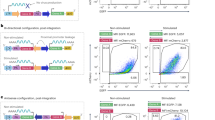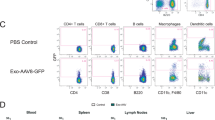Abstract
Genetic modification of T lymphocytes holds great potential for treatments of cancer, T cell disorders and AIDS. While in the past recombinant murine retroviruses were the vectors of choice for gene delivery to T cells, vectors based on lentiviruses can provide additional benefits. Here, we show that VSV-G pseudotyped HIV 1 vector particles delivering the enhanced green fluorescent protein (EGFP) efficiently transduce human T lymphocytes. Transduction efficiency was optimal when infection included centrifugation of cells with concentrated vector supernatant in the presence of Polybrene. In contrast to previous reports describing murine retrovirus-mediated gene transfer to T lymphocytes, fibronectin did not improve the transduction efficiency of the VSVG-pseudotyped HIV-1 particles. Similar gene transfer efficiencies were observed following stimulation of cells with PHA/IL-2 or anti-CD3i/CD28i antibodies, although greater transgene expression was observed in the latter case. Interestingly, production of vectors in the absence of the accessory proteins Vif, Vpr, Vpu and Nef was accompanied by a 50% decrease in transduction efficiency in activated T cells. Transduction of T cells that were not stimulated before infection was achieved. No transduction of non-prestimulated cells was observed with a GALV-pseudotyped murine retroviral vector. The requirement for accessory proteins in non-prestimulated cells was more pronounced. Our results have implications for lentiviral vector targeting of other cells of the hematopoietic system including stem cells.
This is a preview of subscription content, access via your institution
Access options
Subscribe to this journal
Receive 12 print issues and online access
$259.00 per year
only $21.58 per issue
Buy this article
- Purchase on Springer Link
- Instant access to full article PDF
Prices may be subject to local taxes which are calculated during checkout




Similar content being viewed by others
References
Rosenberg SA et al. Gene transfer into humans – immunotherapy of patients with advanced melanoma, using tumor-infiltrating lymphocytes modified by retroviral gene transduction New Engl J Med 1990 323: 570–578
Morgan RA, Anderson WF . Human gene therapy Annu Rev Biochem 1993 62: 191–217
Blaese RM et al. T lymphocyte-directed gene therapy for ADA-SCID: initial trial results after 4 years Science 1995 270: 475–480
Verma IM, Somia N . Gene therapy – promises, problems and prospects Nature 1997 389: 239–242
Naldini L et al. In vivo gene delivery and stable transduction of non-dividing cells by a lentiviral vector Science 1996 272: 263–267
Blomer U et al. Highly efficient and sustained gene transfer in adult neurons with a lentivirus vector J Virol 1997 71: 6641–6649
Kafri T et al. Sustained expression of genes delivered directly into liver and muscle by lentiviral vectors Nat Genet 1997 17: 314–317
Gasmi M et al. Requirements for efficient production and transduction of human immunodeficiency virus type 1-based vectors J Virol 1999 73: 1828–1834
Kim VN, Mitrophanous K, Kingsman SM, Kingsman AJ . Minimal requirement for a lentivirus vector based on human immunodeficiency virus type 1 J Virol 1998 72: 811–816
Zufferey R et al. Multiply attenuated lentiviral vector achieves efficient gene delivery in vivo Nat Biotechnol 1997 15: 871–875
Dull T et al. A third-generation lentivirus vector with a conditional packaging system J Virol 1998 72: 8463–8471
Zufferey R et al. Self-inactivating lentivirus vector for safe and efficient in vivo gene delivery J Virol 1998 72: 9873–9880
Srinivasakumar N et al. The effect of viral regulatory protein expression on gene delivery by human immunodeficiency virus type 1 vectors produced in stable packaging cell lines J Virol 1997 71: 5841–5848
White SM et al. Lentivirus vectors using human and simian immunodeficiency virus elements J Virol 1999 73: 2832–2840
Corbeau P, Wong-Staal F . Anti-HIV effects of HIV vectors Virology 1998 243: 268–274
Poznansky M et al. Gene transfer into human lymphocytes by a defective human immunodeficiency virus type 1 vector J Virol 1991 65: 532–536
Shimada T, Fujii H, Mitsuya H, Nienhuis AW . Targeted and highly efficient gene transfer into CD4+ cells by a recombinant human immunodeficiency virus retroviral vector J Clin Invest 1991 88: 1043–1047
Corbeau P, Kraus G, Wong-Staal F . Efficient gene transfer by a human immunodeficiency virus type 1 (HIV-1)-derived vector utilizing a stable HIV packaging cell line Proc Natl Acad Sci USA 1996 93: 14070–14075
Matsuoka H, Miyake K, Shimada T . Improved methods of HIV vector mediated gene transfer Int J Hematol 1998 67: 267–273
Bunnell BA et al. High-efficiency retroviral-mediated gene transfer into human and nonhuman primate peripheral blood lymphocytes Proc Natl Acad Sci USA 1995 92: 7739–7743
Pollok KE et al. High-efficiency gene transfer into normal and adenosine deaminase-deficient T lymphocytes is mediated by transduction onrecombinant fibronectin fragments J Virol 1998 72: 4882–4892
Fehse B et al. Highly-efficient gene transfer with retroviral vectors into human T lymphocytes on fibronectin Br J Haematol 1998 102: 566–574
Dardalhon V et al. Green fluorescent protein as a selectable marker of fibronectin-facilitated retroviral gene transfer in primary human T lymphocytes Hum Gene Ther 1999 10: 5–14
Case SS et al. Stable transduction of quiescent CD34(+)CD38(−) human hematopoietic cells by HIV-1-based lentiviral vectors Proc Natl Acad Sci USA 1999 96: 2988–2993
Yang S et al. Generation of retroviral vector for clinical studies using transient transfection Hum Gene Ther 1999 10: 123–132
Miyoshi H et al. Transduction of human CD34+ cells that mediate long-term engraftment of NOD/SCID mice by HIV vectors Science 1999 283: 682–686
Quinn ER, Lum LG, Trevor KT . T cell activation modulates retrovirus-mediated gene expression Hum Gene Ther 1998 9: 1457–1467
Douglas J, Kelly P, Evans JT, Garcia JV . Efficient transduction of human lymphocytes and CD34+ cells via human immunodeficiency virus-based gene transfer vectors Hum Gene Ther 1999 10: 935–945
Gabuzda DH et al. Essential role of vif in establishing productive HIV-1 infection in peripheral blood T lymphocytes and monocyte/macrophages J Acq Immun Def Syn 1994 7: 908–915
Inubushi R, Adachi A . Cell-dependent function of HIV-1 vif for virus replication Int J Mol Med 1999 3: 473–476
Nascimbeni M et al. The replicative impairment of Vif- mutants of human immunodeficiency virus type 1 correlates with an overall defect in viral DNA synthesis J Gen Virol 1998 79: 1945–1950
Miller MD et al. The human immunodeficiency virus-1 nef gene product: a positive factor for viral infection and replication in primary lymphocytes and macrophages J Exp Med 1994 179: 101–113
Heinzinger NK et al. The Vpr protein of human immunodeficiency virus type 1 influences nuclear localization of viral nucleic acids in nondividing host cells Proc Natl Acad Sci USA 1994 91: 7311–7315
Zack JA . The role of the cell cycle in HIV-1 infection Adv Exp Med Biol 1995 374: 27–31
Adra CN, Boer PH, McBurney MW . Cloning and expression of the mouse pgk-1 gene and the nucleotide sequence of its promoter Gene 1987 60: 65–74
Pear WS, Nolan GP, Scott ML, Baltimore D . Production of high-titer helper-free retroviruses by transient transfection Proc Natl Acad Sci USA 1993 90: 8392–8396
Chen CA, Okayama H . Calcium phosphate-mediated gene transfer: a highly efficient transfection system for stably transforming cells with plasmid DNA Biotechniques 1988 6: 632–638
Acknowledgements
We are grateful to V Dardalhon and N Taylor for providing the GALV pseudotyped MLV vector. The plasmids, pCMVΔR8.9, pCMVΔR8.2, and pMD.G were the generous gifts of R Zufferey and D Trono. We thank Annelyse Vessaz-Shaw and Verena Mueller for excellent technical assistance and are grateful to Jean-Baptiste Pellet for constructing the pHR CMV EGFP plasmid. This work was funded by the Swiss National Science Foundation (Grant number: NFP37 4037–044732).
Author information
Authors and Affiliations
Rights and permissions
About this article
Cite this article
Costello, E., Munoz, M., Buetti, E. et al. Gene transfer into stimulated and unstimulated T lymphocytes by HIV-1-derived lentiviral vectors. Gene Ther 7, 596–604 (2000). https://doi.org/10.1038/sj.gt.3301135
Received:
Accepted:
Published:
Issue Date:
DOI: https://doi.org/10.1038/sj.gt.3301135
Keywords
This article is cited by
-
Effects of polybrene and retronectin as transduction enhancers on the development and phenotypic characteristics of VHH-based CD19-redirected CAR T cells: a comparative investigation
Clinical and Experimental Medicine (2022)
-
Steroid receptor coactivator 3 (SRC-3/AIB1) is enriched and functional in mouse and human Tregs
Scientific Reports (2021)
-
A new chemical complex can rapidly concentrate lentivirus and significantly enhance gene transduction
Cytotechnology (2018)
-
Optimization of methods for the genetic modification of human T cells
Immunology & Cell Biology (2015)
-
Cell Type-Specific Targeting with Surface-Engineered Lentiviral Vectors Co-displaying OKT3 Antibody and Fusogenic Molecule
Pharmaceutical Research (2009)



